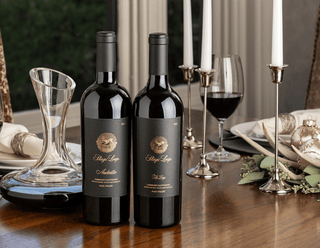Tasting wine is a journey that engages all the senses, where the interplay of sight, smell, and taste unfolds to create the full experience of the wine. Dive into the classic 4S tasting framework of see, swirl, sniff and sip to heighten your overall tasting experience.

See
Before the glass touches your lips, the wine begins to tell its story through its visual characteristics. Start by holding the glass against a white background and examine its hue, clarity, and color. Together, these tell a story about the wine’s age and which varietals were blended into the wine.
The clarity speaks to the wine’s filtration and aging. More mature wines might have more sediment, while younger ones will have more opacity.
Swirl the wine gently in the glass and observe the "legs" that form on the sides. These hint at the wine's body and alcohol content.
Swirl
Swirling a glass of wine releases unique aroma compounds that then attach themselves to oxygen. It also releases a chemical component called esters which open the flavors on the palate. In short, the swirl introduces oxygen the wine has been lacking in the bottle and allows its flavors and aromas to bloom.
If you’ve ever wondered if the shape of your glass matters, this step makes the answer clear. Wide-bowled glasses allow for a larger surface area, giving the wine more exposure to air, while narrower glasses concentrate the aromas.
Sniff
The aromas of a wine are just as important to the experience of the wine as the actual juice is. When sniffing your glass, see if you can identify the primary, secondary and tertiary aromas. The primary aromas are the pure fruit aromas, like the burst of blackberries in a young cabernet sauvignon or the vibrant citrus notes of a crisp sauvignon blanc. The secondary aromas come from the aging process. Look out for vanilla, baking spices and toastiness. These aromas add complexity to the wine and can be controlled by the winemaker.
Wines develop tertiary aromas with age. You’ll get more complex scents like tobacco, earthiness and dried fruits. These are the marks of a wine that has gracefully matured.

Sip
The final step is, of course, tasting. As you sip the wine start by noticing its texture. Is it light and delicate or full-bodied and rich? These textural elements lead to the wine’s structure and mouthfeel. Next, consider the flavors. This is an incredibly subjective element. Everyone will taste different flavors in a wine, there is never a right answer! Some classic flavors for red wines include blackberry, cherry and black currant. In lighter white wines you’ll hear people mention crisp apple, melon and lemon.
The wine’s finish is what lingers on your palate after you swallow, its final farewell. Notice if it’s short and crisp or if it resonates and leaves a lasting impression.



